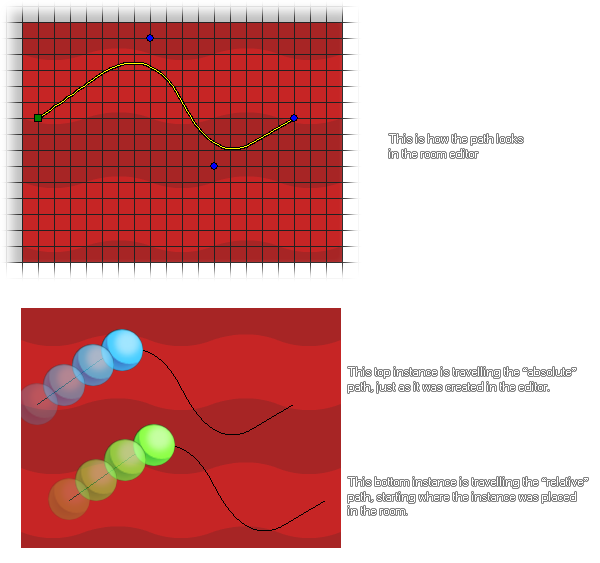
path_start(path, speed, endaction, absolute);
| Argument | Description |
|---|---|
| path | The path index to start. |
| speed | The speed of which to follow the path in pixels per step, negative meaning going backwards. |
| endaction | What to do when the end of the path is reached (see the constants listed below). |
| absolute | Whether the calling instance should follow the absolute path as it is in the editor (true) or a relative path to its current position (false). |
Returns: N/A.
A path is created from a series of defining points that are
linked together and then used to plan the movements of an instance.
They can be created with code, or in the Path Editor and
they are assigned to an instance to use in the game. You would then
use this function to tell your instance which path to follow, what
speed to follow the path (measured in pixels per step), how to
behave when it reaches the end of the path, and whether to follow
the absolute or relative path position. This last
part means that it either starts and follows the path exactly as
you designed and placed it in the Path Editor (absolute), or it
starts and follows the path from the position at which the instance
was created (relative).

As you can see in the above image, the two instances are
following the same path started with path_start(), but one
of the instances is following the absolute path while the other is
following the relative path. It should be noted that when relative
is set to false (absolute) the instance will "jump" to the start of
the path no matter where in the room it is placed.
The constants used to define the behaviour of the instance when it
reaches the end of the path are as follows:
| Constant | Description |
|---|---|
| path_action_stop | End the path |
| path_action_restart | Continue the path from the start, jumping to the start position again if the path is not closed |
| path_action_continue | Continue from the current position |
| path_action_reverse | Go backwards along the path again (achieved by reversing the path movement speed) |
path_start(path, 4, path_action_reverse, 0);
This will make the calling instance follow the path indexed in the variable "path" at a speed of 4 pixels per step. It will follow the path relative to its own position, and when it reaches the end it will reverse direction and go back the way it came.